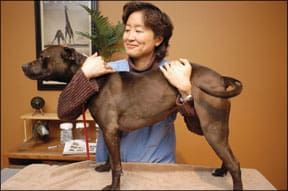A training friend suggested that I read Low Stress Handling, Restraint, and Behavior Modification of Dogs and Cats, by applied animal behaviorist Sophia Yin, DVM, MS. As an owner whose dogs have taken their fair share of visits to vet clinics, I really liked what I read. Dr. Yin’s text takes a critical look at how our pets are often handled in veterinary clinics – and it’s not pretty, as you may have seen yourself. Fortunately, she also offers common sense advice on approaching veterinary care so as to make it as stress-free as possible for our pets.

Popular myths abound that force is needed to get animals to behave. Instead, Dr. Yin focuses on how to modify behavior quickly in a veterinary setting using a systematic and positive approach. Her methods involve classical conditioning to change the pet’s emotional state; setting up the veterinary environment to ensure the pet’s comfort; teaching us how to handle animals with appropriate, rather than stronger, restraint; and how to behave around animals so as to avoid creating problems. The book is the result of over a thousand hours of work and features more than 1,600 photos and three hours of video. A copy belongs in every veterinarian’s hands; proactive pet owners can benefit as well (the text is pricey, however).
I interviewed Yin in late 2009 to hear more about her latest book and how we, as pet owners, can help our dogs have less stressful veterinary visits. The vet office does not have to be a nasty place, and Yin, as a veterinarian herself, wants to help us, our veterinarians, and their staff make the clinic experience a better one for all of us, especially our beloved dogs! Although lots of her ideas are common sense, if you’re like me, you’d welcome seeing them adopted by your dog’s veterinary hospital sooner rather than later.
Rodier: The book is a great resource, but very different from any behavior and training books that are out there. Who is the intended audience?
YIN: The book is for anybody who deals with many different dogs and cats or who just wants to know how to better handle their pet for everyday husbandry procedures.
Initially, I wrote it for veterinarians, as a complete guide to handling and dealing with animals. But really, it is for anybody who works with a lot of dogs and cats. That includes shelter workers, shelter volunteers, groomers, and even kennel workers. The book is not just about handling animals, it’s also about how to set up the environment so the animal is more comfortable, as well as how to act around animals so that you don’t introduce a problem that previously didn’t exist, how to read your pet’s body language, and how to gauge whether your techniques are having the intended effect. The book also has a lot of techniques that pet owners can use at home to better prepare their pet for a veterinary visit.
It was a huge undertaking. Why do it?
A number of veterinary behaviorists were recommending new techniques for handling animals – techniques that were very different from what vets have been taught for decades. For instance, they said that we shouldn’t be “scruffing” cats anymore. That’s one of the first things we learn in veterinary school, how to scruff a cat! It made me wonder: Which techniques should we use and how do we know which ones will work?
I started by observing what technicians and veterinarians were doing. I took a lot of video so that I could analyze why some people and techniques were successful and why others were not. At first, I thought the book might be quite thin; but the more I saw, I realized there was lots of room for significant improvements in handling. In fact, I found that most veterinary professionals do not handle animals well; they just get lucky! This finding includes first-rate veterinary technicians who have years of experience. It’s surprising, but no matter how long people have worked with animals, maybe 10, 20, or even 30 years, they might have been making the same handling mistakes the entire time!
That’s because we handle dogs the way we’ve been taught, or the way we think works. But people often aren’t very mindful of what the animal needs or if the technique they use is the best way. Does the animal feel comfortable the entire time, or are we doing things that make him feel the need to struggle? Or are we causing him to show signs of fear, or to be a little tense?
What I found is that handling is like a sport requiring skill and finesse. If you don’t know exactly where to have your hands and body in relation to the dog, you won’t be able to restrain him appropriately. This holds true even when doing something as simple as keeping a dog from pacing, lifting him on a table, or putting him onto his side.
On the DVD (that comes with the book) I included video footage of a technician flopping a dog on his side, something that happens at every veterinary hospital. The dog is standing and all of a sudden he’s on his side and hits his head during the transition! Can you imagine if you went to a physical therapist and she yanked your feet out from under you and you hit your head? Techniques like this should not be in use.
One bad veterinary experience can cause a dog to aggress on future visits. Why is this?
Many dogs are already fearful before even getting to the clinic. For example, the dog who usually behaves, but stands still and trembles due to fear. Because she doesn’t try to bite or struggle, everyone thinks she’s okay. The problem is that with each visit she’s likely to get worse, because each visit is frightening for her from start to finish. And if something that she perceives to be really bad happens to her, she can easily switch from being frozen or wanting to hide in fear, to feeling that she needs to defend herself by growling or biting for the first time.

Some dogs are able to take things like having blood drawn or being restrained for X-rays in stride; the fearful dog blows these experiences out of proportion.
So my dog’s had a bad experience at the vet. Now what? Can I fix it?
You can fix it. Depending what the experience was, we can do things to train the dog to associate the animal hospital with good things. You want to get help when you do this, somebody – a positive trainer or behaviorist who understands principles of behavior modification – to guide you through it, so you can do it efficiently and positively. The goal is to pair the clinic with good things, and handling with good things. The person you work with should be somebody who can list for you all the signs of fear and anxiety in a dog so that you would know how to recognize them. They should be able to use a number of different types of reward-based techniques, versus the “Let’s show ’em who’s boss” approach.
I don’t recommend using a choke chain or a pinch collar; this indicates a desire to give corrections. Choke chains and pinch collars are sort of a vague punishment of something you didn’t like; the information they send to the dog is not very good. They work by causing pain or fear of pain. The problem – a fear of veterinary experiences – is fear-based! We definitely don’t want to have pain or fear involved.
Head halters can be aversive to a dog, too, because the dog can’t move his head where he wants. However, they at least guide him into position, so you can more precisely give the dog information about what you want him to do.
You also want to avoid any trainer who says, “We don’t use food!” I gave a lecture on using desensitization and classical conditioning for veterinary procedures and showed video of dogs getting better using all these techniques. A fellow behaviorist heard a person from the sponsoring group say “Oh, her methods don’t work.” Then, publicly, the sponsoring representative said, “We do just what Dr. Yin does, but with less food.” The audience practically sighed out loud. They recognized that when training a dog to like having her toenails trimmed or getting injections, praise and petting were probably not going to cut it in most cases.
Food is a strong motivator for dogs. The food is being used to create a positive emotional state. You can use other things, too, but you don’t want to take away one of your strongest motivators! The person who helps you needs to understand that your goal is to change the emotional state of the dog from scared to calm, comfortable, relaxed, and happy.
I recommend that people bring their pets to the hospital hungry; withhold the previous meal and bring it along with tastier treats to the visit. Treats should be bite-sized so that the dog can consume a single treat in 1 to 2 seconds. Giving 5 to 15 small treats in rapid succession is better than giving one large treat because the sequence of treats can be used to extend the period of time in which the dog is in a positive emotional state.
In general, soft treats such as tiny pieces of hot dog, diced chicken, or chopped Natural Balance food roll work better than dry treats, although many dogs are fans of freeze dried liver or Liver Biscotti. Even consider using canned spray cheese or peanut butter spread thin on a spoon. Don’t worry about overfeeding or imbalancing the diet. A positive veterinary experience is more important than having a balanced diet on one particular day.
Is there a relationship between force-based training methods and the type of handling that has typically been used by animal professionals?
The traditional view is that if we want to get an animal to do something, we force it to do so. Face it, the easiest way for people to do things is without thinking, and force requires less thought. There’s also the attitude of “I’m just going to do what I did before, or what somebody showed me, and I’m not going to evaluate whether it’s working or consider whether there’s a better way.”
People don’t necessarily consider what works best for the dog. Take, for example, trying to guide a dog to sit. Many times a veterinary professional will guide the dog in a way that’s stressful for the dog. To get the dog to sit, he puts pressure on the dog’s body, but the dog doesn’t know what he wants. The handlers should notice any time the dog struggles to get away, or her ears go back; these things should make them question whether they’re handling the dog correctly.
If the dog struggles multiple times, more than two seconds, then you need to do something else. Coming from a traditional training background, there are times when I thought “I need to show this dog!” and those are the times I’ve gotten into trouble. I’ve been bitten only when I was doing that! It is hard to get rid of that mentality, but it doesn’t serve a good purpose. The “must win” attitude is about your ego, really.
Another problem with that “put him in his place” attitude is that once you’ve got the dog aroused, he’s more likely to react to a smaller trigger the next time. Once he’s excited, his epinephrine and corticosteroid levels have shot up. They’ll go down, but maybe not before another potentially high arousal event. It’s just like when you have a frightening experience like a near car accident, and then later in the day you see a spider. Although you usually can handle being near a small spider, when you’ve already had one scary incident earlier in the day, your threshold for other heart-pounding events is much lower and you’re more likely to freak out.
With dogs, that’s when we get the stories of people telling us that the dog bit or lunged “without warning.” Really, the person most likely just didn’t see the warnings, or because the dog is already aroused, his trigger was much smaller. Also, many times our dogs do something a little earlier that indicates they are fearful and an event is stressful for them, and when we fail to back off or help them, we push them to respond aggressively.
Will animal professionals really want to use new, gentle techniques even if they require time to learn and to use, margins are tight, and volume is the key to making money?
It’s actually way faster when you use “low stress” techniques; they can save time, manpower, and lost work days due to bite-related injuries. If the animal hospital staff can’t put their hands on the animal correctly every single time, then they’re going to make the animal worse. Once it gets worse, it takes a lot more time to make it better than if you do it right the first time.
Look, it doesn’t take long to offer a couple of treats to a dog in the clinic. When you classically condition a dog, you train him to like certain procedures; as a result, each visit gets better and the clients are happier. It’s rarely the case that dogs “just get better,” behaviorally, at the hospital, without some work.
But making it less stressful for the dog doesn’t just involve giving treats. It involves knowing how to set up the exam room, and even teaching the owners how to prepare their dogs beforehand. Maybe you need to get your dog into the exam room before he gets amped up from being in the waiting room with dogs and cats he’s afraid of. And then, in the exam room, the veterinarian needs to approach the right way, instead of scaring the dog by approaching head on, like a big scary ogre.
Every time the vet or technician interacts with the dog, they need to realize that the dog is learning something from them. How they place their hands on the dog, how they hold the dog’s collar, where they’re standing in relation to the dog; all of this is noticed by the dog. Even little things that people do can ruin the exam.
Can you give an example?
I worked with an excitable dog who belonged to a friend. She said, “How did you control her?! At our veterinary hospital, he was horrible.” It’s because the veterinarian there was letting the dog pace around. Instead of just quietly asking the dog to sit and then grasping the collar with one hand and perhaps placing the other hand on her hip so that the dog understood that he wanted her to hold still, the veterinarian just got down to her level and she climbed all over him. Good handling may involve something as simple as shortening the leash and keeping it short, but loose.

Here’s another example: If you want to guide the dog to sit, one thing is sure: his back legs need to bend in order for him to sit! And his weight needs to be off his front end and toward the rear end. If you’re unable to appropriately guide the dog into a posture that makes it easy for him to sit, he might become anxious and defensive, and even aggressive.
How do I convince my dog’s veterinarian to use these techniques?
I’ve heard from several trainers that their veterinarians have implemented the techniques, and the staff is so much better at handling. Let your veterinarian know that good handling is important to you, and let her know there is a credible textbook from which she can learn. Approached in this way, she’ll very likely take it into consideration. It’s about clearly communicating your expectations to the veterinarian.
Might this be offensive?
It’s your pet you’re talking about! If the veterinarian or her staff handles your dog poorly, and your dog becomes increasingly anxious or defensive, you might not be able to get continued medical care for him. Treatments are less successful if they are delivered under duress to a stressed dog. The worse our dogs’ experiences are over time, the worse they will become at the hospital. What if your dog has to stay at the veterinary clinic for a medical procedure? And how is he going to feel during that medical procedure if he knows he’s going to be handled poorly?
Consider what’s going on, physiologically: The higher the dog’s stress level, the more hormonal changes he’ll suffer, with a decrease in his immune function. If he’s staying in the hospital and he’s sick and scared about poor handling, it will be harder for him to recover. You are responsible for your pet. You shouldn’t be rude to the doctor or his staff, but you should let them know that your dog does better when he’s handled a certain way. The more you know, the more suggestions you can offer. It’s important to know your dog. If you don’t know how he’s going to respond or how to handle him, then leave it up to the veterinarian. But if you’ve used some of the techniques, worked through some of your dog’s issues, and know what your dog is well-behaved and trained, you need to share that information.
I have a client whose dog was really well behaved and well trained. The veterinarian took the dog away to perform a procedure and the dog was yelping and screaming. Well, all the veterinarian wanted the dog to do was lay on his side. So the owner said, “Bang!” to the dog, and the dog lay flat on his side, as he’d been trained to do on that cue. The more you can show that you have good control of your dog, the more authority you can have with how you want your dog handled. But, if you don’t actually have good control over your dog, it’s safer for the vet to be in charge of the handling.
How about vets who don’t perform procedures such as blood draws in front of us; how do we know how they’re handling our dogs?
I would see how the dog is when he comes back. Does he look more anxious or is he relaxed? If he was handled well, he should get better. He shouldn’t look worse than when he left you.
If our vets won’t follow these protocols, should we vote with our feet?
Some people are not going to be open to change, no matter what, so you might need to go to a different hospital. Or maybe it’s just one technician and you need to talk to the doctor.
If you tell them “I want you to handle my animal better,” they may not know what you want. But if you say, “Have you seen this book about proper handling techniques for veterinary practices?” They should be aware there is a credible source of pertinent, useful information. I’ve gotten feedback from trainers who are happy to have this resource for their vets.
How do you convince dog owners that it’s worth taking the time to follow some of the tips you offer?
Many people think that dogs are supposed to be afraid of the veterinarian; some people think that’s normal. And really, it’s not! Most veterinarians’ dogs are fine at the clinic, because their dogs visit often and at times other than for procedures. So I think, number one, the idea of the veterinary clinic being scary needs to change.
At home, we as pet owners can train our dogs to lie down on their sides, and to get in the different positions that the veterinary staff will require of them. We can teach them to enjoy taking pills, receiving shots, or having their nails trimmed. If you can show the veterinarian that you can do these things with your dog, he will be more likely to go along with what you say. Not every dog owner is going to be an ace at handling, but if he think that the handling is rough at the veterinary clinic he uses, and he at least knows that there are alternatives, he can inform the staff about those alternatives.
But it does come back to the veterinarians. They need to make their hospitals happier and more comfortable, with treats and toys, washable throw rugs, and a calm, not hectic, environment. Hospitals need to be an environment the animals experience as somewhat fun – especially for puppies! Pups haven’t had a chance for anything bad to happen yet, and they shouldn’t!
For more on Sophia Yin, DVM, MS, visit her website.
Lisa Rodier, a freelance writer, lives in Alpharetta, Georgia.






